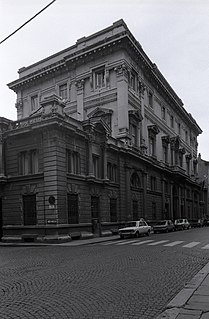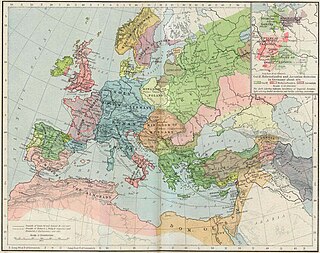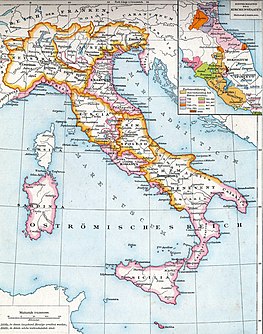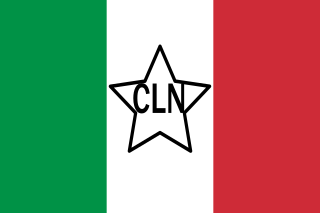
Bobbio is a small town and commune in the province of Piacenza in Emilia-Romagna, northern Italy. It is located in the Trebbia River valley southwest of the town Piacenza. There is also an abbey and a diocese of the same name. Bobbio is the administrative center of the Unione Montana Valli Trebbia e Luretta.

The Trebbia is a river predominantly of Liguria and Emilia Romagna in northern Italy. It is one of the four main right-bank tributaries of the river Po, the other three being the Tanaro, the Secchia and the Panaro.

Apennins[a.pɛ.nɛ̃] was a department of the First French Empire of 1804-1814 in present-day Italy. Named after the Apennine Mountains, it originated on 6 June 1805, after France had directly annexed the Ligurian Republic on 4 June 1805. Its capital was Chiavari.
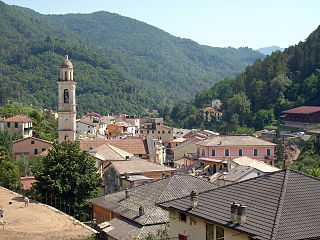
Borzonasca is a comune (municipality) in the Metropolitan City of Genoa in the Italian region Liguria, located about 35 km (22 mi) east of Genoa.

Rezzoaglio is a comune (municipality) in the Metropolitan City of Genoa in the Italian region Liguria.
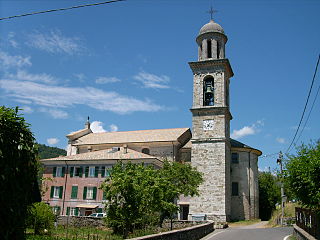
Rovegno is a comune (municipality) in the Metropolitan City of Genoa in the Italian region Liguria, located about 35 kilometres (22 mi) northeast of Genoa, in the Val Trebbia. Rovegno borders the following municipalities: Fascia, Fontanigorda, Gorreto, Ottone, Rezzoaglio.

Torriglia is a comune (municipality) in the Metropolitan City of Genoa in the Italian region Liguria, located in the upper Trebbia valley, about 20 kilometres (12 mi) northeast of Genoa. Torriglia borders the following municipalities: Davagna, Lorsica, Lumarzo, Mocònesi, Montebruno, Montoggio, Neirone, Propata, Rondanina, Valbrevenna.

Ferriere is a comune (municipality) in the Province of Piacenza in the Italian region Emilia-Romagna, located about 150 kilometres (93 mi) west of Bologna and about 45 kilometres (28 mi) southwest of Piacenza, in the Val Nure of the Ligurian Appennines.

The Aveto Natural Regional Park is a natural park in Metropolitan City of Genoa, in the Liguria region of northern Italy). It was established in 1995.

Monte Maggiorasca is a mountain on the border between Liguria and Emilia-Romagna, northern Italy.
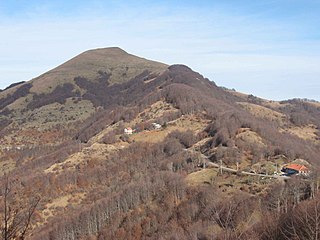
Monte Carmo is a mountain in the Ligurian Apennine, northern Italy.

Monte Alfeo is a mountain in the Ligurian Apennine, located in the territory of the commune of Ottone, province of Piacenza, central Italy, in the left bank of the Val Trebbia. Having an altitude of 1,651 m, it is part of the Monte Antola group.
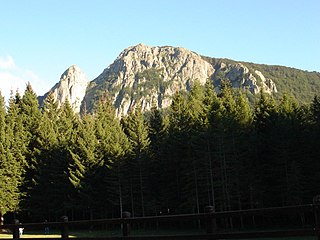
Monte Penna is a mountain (1,735 m) on the border between Liguria and Emilia-Romagna, northern Italy, part of the Ligurian Appennines. It is included in the Natural Regional Park of the Aveto, and overlooks the Val di Taro; the sources of both the Taro and Ceno Rivers are located in Monte Penna's slope.

The Val Nure is the valley of the Nure river, a tributary of the Po. The valley lies almost entirely in the Province of Piacenza, in the Emilia-Romagna region of Italy. It forms part of the Comunità Montana Valli del Nure e dell'Arda.
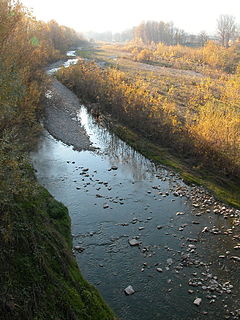
The Tidone is a river in the Region of Emilia Romagna in northern Italy. It is a right-bank tributary of the Po River. The stream rises in the Apennine Mountains near Monte Penice and flows in a northerly direction into the Po.

The Metropolitan City of Genoa is one of the fourteen Metropolitan cities of Italy, located in the region of Liguria. Its capital is the city of Genoa. It replaced the Province of Genoa.
The Antola Natural Regional Park is a natural park in Metropolitan City of Genoa. It gets the name from the highest mountain of the area, Monte Antola.

